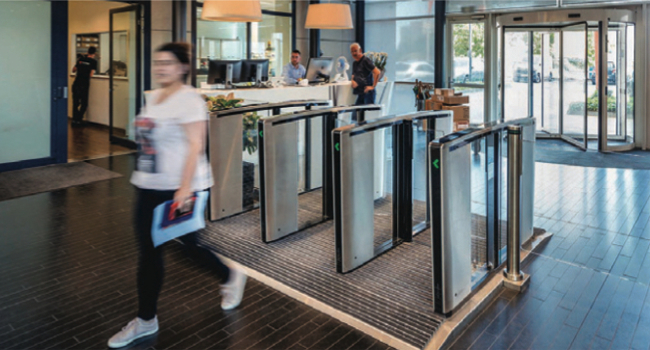
INDUSTRY PROFESSIONAL
Navigating the Retrofit
The new dynamics of security and safety mandates for security entrances
- By Greg Schreiber
- May 26, 2021
Most security managers know that security technology has come a long way in the last few years, and equipment and systems purchased five or 10 years ago will need to be updated or replaced. When the update plan includes security entrances, like turnstiles and revolving doors, the project may bring unique challenges and pitfalls. With careful planning and foreknowledge, pitfalls can be avoided. New security entrances can be integrated without compromising security or safety.
The Role of Turnstiles in Physical Security
The past year has highlighted the importance of security in general, and brought to the forefront the role that security entrances can mitigate the costly liabilities associated with unauthorized entry, but also assisting in the safety and wellbeing of staff during a pandemic. Understanding their responsibility for “duty of care” to those occupying their spaces, building owners and security professionals must account for the changing social landscape and the growing options of available entrance technologies for controlling access.
Retrofit First Step Includes Determining Security Goals
When building owners are looking to upgrade the physical security of their facilities through the use of security entrances, the first step should be to clearly define the organization’s security goals, gaining a solid understanding of the threat and culture of the facility. With this information in hand, it will be possible to choose the right revolving door or turnstile solution that will not only meet an organization’s needs, but also be a good fit with the corporate culture.
The obvious challenge of a security retrofit project is that the new technology is often replacing a solution that already exists. It’s also possible that existing technologies, in many instances, are still a part of the retrofit plan. To aid in the process, security professionals should develop a strategic retrofit roadmap ahead of time. This map will outline how to keep existing systems and devices functioning while the retrofit is in progress. When this map is communicated to others in the organization, there is a sense of transparency towards staff, employees and other stakeholders.
The Biggest Challenge is on the Floor
As security dynamics shift with changing technology, most systems integrators will tell you the goal is to design entrances that are on the cutting edge of security but balanced with the need to welcome people and move them through quickly. Many security entrance projects are retrofits to existing buildings and the biggest challenge usually revolves around the flooring in the facility.
The floor must be dead level for a security entrance to work properly. In the case of a security revolving door, a door rotating on an uneven floor will put undue stress on the door wings and the door operator. The wear and tear will be excessive and the door will have to be replaced sooner than expected. Shimming is a popular method for trying to square a door on an unleveled floor. However, the shims will eventually force the door out of balance and plum, resulting in a door that is hard to push, is excessively loud when operating and will eventually fail prematurely.
For lobby turnstiles, all conduits and wiring for electrical, access control and fire connections should be run through the floor. Existing flooring configurations, especially when the floor is made of concrete with existing conduit inside, often require breaking and removing the floor to install the new wiring and conduit in the appropriate locations. This adds considerable expense to the project and may also be technically prohibitive depending on the building. One potential solution of existing wiring in concrete flooring is to add special, above-grade platforms that are mounted to the floor surface under the turnstiles.
Power, access control, fire alarm connections and proper flooring/conduit requirements must be properly addressed to ensure a smooth and cost-effective installation. These items should be in place and functional before the installation begins.
Additional Retrofit Considerations
Safety is rarely discussed during the bidding process in a retrofit project. However, it is the one factor that could quickly and possibly tragically undermine the success of the project. Most security entrances use a barrier of some kind. The more sophisticated barriers use presence sensors to detect objects or users. Building owners looking to upgrade security entrances should carefully consider how proposed solutions will prevent entrapment or contact, and how they should respond to either event.
These decisions should then be based on the facility’s security versus safety needs, the ability and ease of product training for staff, the product’s response to an incident during peak periods (does it stop and require re-badging?) and whether large objects are typically carried or pulled behind.
Another consideration relates to the upgrade of older security entrance technologies to larger-sized products, especially when space is limited in an older building. Larger products can lead to having fewer products – be sure to check your traffic and throughput needs before you reduce the number of entrances.
Include service considerations when making a buying decision. During and after installation of a security entrance, the level of service directly impacts continued operations and ROI. Consider the negative impact of a delayed installation or service visit, or delayed parts availability on your building entrance procedures – all because service was left out of the decision-making process.
A final and key consideration on your next retrofit project is considering the culture of the organization the new or upgraded technology will serve. Culture permeates all other decision factors and is critical to success. Successful security policy is a direct result of top-to-bottom commitment to both technology and business operations. All management stakeholders involved in the buying decision, from CEO to employees, should be an intimate part of the retrofit process and be willing to assist in implementing a culture shift through communication and training.
This article originally appeared in the May June 2021 issue of Security Today.